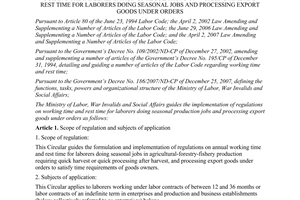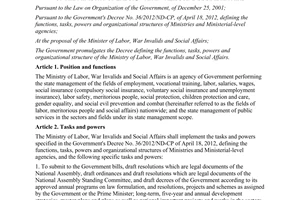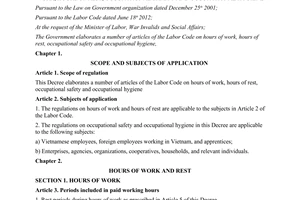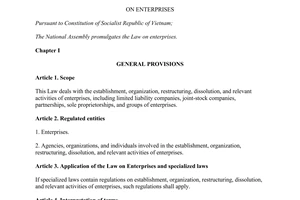Nội dung toàn văn Circular No. 54/2015/TT-BLDTBXH hours work rest applicable employees doing seasonal work processing
|
THE MINISTRY OF
LABOR, WAR INVALIDS AND SOCIAL AFFAIRS |
SOCIALIST REPUBLIC
OF VIETNAM |
|
No. 54/2015/TT-BLDTBXH |
Hanoi, December 16, 2015 |
CIRCULAR
ON GUIDELINES FOR HOURS OF WORK, HOURS OF REST APPLICABLE TO EMPLOYEES DOING SEASONAL PRODUCTION WORK AND PROCESSING OF GOODS UNDER ORDERS
Pursuant to Article 117 of the Labor Code dated June 18, 2012;
Pursuant to the Government’s Decree No. 45/2013/ND-CP dated May 10, 2013 on guidelines for the Labor Code on hours of work, hours of rest, occupational safety and occupational hygiene;
Pursuant to the Government's Decree No. 106/2012/ND-CP dated December 20, 2012, defining the functions, tasks, powers and organizational structure of the Ministry of Labor, War Invalids and Social Affairs;
At the request of the Director of the Department of Labor safety,
The Minister of Labor, War Invalids and Social Affairs promulgates a Circular on guidelines for hours of work, hours of rest applicable to laborers doing seasonal jobs and processing export goods under orders.
Article 1. Scope
This Circular provides guidelines for making plan and implementation of hours of work, hours of rest applicable to employees doing seasonal jobs and processing of goods under orders.
Article 2. Regulated entities
1. Laborers working under labor contracts of between 12 and 36 months or labor contracts of an indefinite term for the following jobs:
a) Seasonal production work in the fields of agriculture – forestry – fishery - salt production that require instant harvest or instant processing after harvest without delay;
b) Processing of goods under orders, of which delivery time requested by the goods owners, including the fields of textile and garment, leather and footwear, electronic component installation.
2. Employers of the laborers mentioned in the Clause 1 of this Article are the following enterprises and business entities:
a) Companies and enterprises operating under the Law on Enterprise;
b) Cooperatives and cooperative unions operating under the Law on Cooperatives and employing laborers under labor contracts.
Article 3. Standard hours of work in a year
TQ = [TN - (Tt + Tp + TL)] X tn (hours)
Where:
- TQ: A laborer’s standard hours of work in a year;
- TN: Number of days in a year, which is 365 in a calendar year, or 366 in a leap year;
- Tt: Total number of weekly days off in a year, determined under Article 110 of the Labor Code;
- Tp: Number of annual leave days, which is 12, 14 or 16 and may be increased depending on working seniority under Articles 111 and 112 of the Labor Code and Article 7 of Decree No. 45/2013/ND-CP dated May 10, 2013 on guidelines for the Labor Code on hours of work, hours of rest, occupational safety and occupational hygiene;
- TL: Number of official holidays in a year, which is 10;
- tn: Number of daily normal hours of work, which is 8; particularly for laborers doing extremely hard, hazardous and dangerous jobs on the list issued by the Ministry of Labor, War Invalids and Social Affairs, this number is 6.
Article 4. Formulating plan for determination of daily standard hours of work
Annually, based on the standard hours of work in a year (TQ) calculated as prescribed in Article 3 of this Circular, each employer shall make a plan to determine the number of daily standard hours of work of each laborer in the following cases:
1. The number of daily normal hours is 8; or 6, for laborers doing extremely hard, hazardous and dangerous jobs;
2. The number of daily hours of work may be more than 8 but may not exceed 12; or may be more than 6 but may not exceed 9, for laborers doing extremely hard, hazardous and dangerous jobs;
3. The number of daily hours of work may be more than 4 but must be fewer than 8; or may be more than 3 but must be fewer than 6, for laborers doing extremely hard, hazardous and dangerous jobs;
4. A whole day-off is allowed.
Article 5. Principles of using the standard hours of work
1. In a year, the total number of standard hours of work planned and determined under Clause 4 of this Article (including daily hours of rest expressed as hours of work) must not exceed the standard hours of work in the year (TQ) already determined in Clause 3 of this Article.
2. In case the number of daily standard hours of work which is fewer than 8; or fewer than 6, for laborers doing extremely hard, hazardous and dangerous jobs, has been planned and determined under Clauses 3 and 4 of this Circular, job stoppage wage needs not to be paid.
3. Job stoppage wage must be paid for the number of daily standard hours of work already planned during which a company actually did not arrange work for its laborers.
4. In case the number of daily standard hours of work which is more than 8; or more than 6, for laborers doing extremely hard, hazardous and dangerous jobs, has been determined under the plan mentioned in Clause 2 Article 4 of this Circular, such difference in hours may not be counted as extra working time.
5. The number of actual daily hours of work in excess of the number of standard hours of work already planned under Article 4 of this Circular may be counted as extra hours of work to be added to the total number of extra hours of work in a year and, at the same time, overtime pay and other relevant benefits must be provided under current regulations of the Labor Code.
Article 6. Maximum daily standard hours of work and extra hours of work
1. The total maximum number of standard hours of work and extra hours of work in a day is 12; or 9, for laborers doing extremely hard, hazardous and dangerous jobs.
2. Maximum weekly and monthly standard hours of work and extra hours of work:
a) The total maximum number of standard hours of work and extra hours of work in a week is 64; or 48, for laborers doing extremely hard, hazardous and dangerous jobs.
b) The total maximum number of extra hours of work in a month is 32; or 24, for laborers doing extremely hard, hazardous and dangerous jobs.
c) The employer shall apply either maximum weekly standard hours of work and extra hours of work prescribed in Point a or maximum monthly extra hours of work prescribed in Point b of this Clause, and then record it into a plan for annual hours of work and hours of rest prescribed in Clause 1 Article 8 of this Circular.
If the employer decides to apply the maximum monthly extra hours of work prescribed in Point b of this Clause, the total of weekly standard hours of work shall do not exceed 56 hours; or 42 hours, laborers doing extremely hard, hazardous and dangerous jobs.
3. Total of extra hours of work in a year of each laborer shall not exceed 300 hours.
Article 7. Hours of rest
1. Laborers are entitled to at least one day off (24 consecutive hours) a week. In seasonal-work months or when export goods must be urgently processed under orders, if weekly days off cannot be arranged, the employer shall arrange at least 4 days off every month for laborers.
2. During-shift and between-shift breaks for laborers comply with the provisions of the Labor Code. For laborers working 10 or more hours a day, the employer shall allow them to have at least extra 30 minutes off included in hours of work besides hours of rest during normal working shifts.
3. Enterprises shall allow laborers to take all official holidays, annual leave days and other paid days off or other days off in compensation as prescribed in the Labor Code.
Article 8. Responsibilities of employers
1. Annually, based on their production and business plans, each employer shall take the initiative in formulating and adjusting their plans on hours of work and hours of rest, using the form provided in Appendix 1 issued herewith. The employer must consult grassroots trade union executive boards of their enterprises. The employer shall refer to the examples in Appendix 2 issued herewith during the formulation and implementation of the plan for hours of work and hours of rest.
If ascertaining that the number of daily normal hours of work is only 8, or 6, for laborers doing extremely hard, hazardous and dangerous jobs, enterprises are not required to formulate plans under the above Appendix 1.
2. The employer shall notify laborers within their enterprises of plans on hours of work and hours of rest at least 30 days before implementation, and reach agreement with laborers on overtime work under regulations of the Labor Code.
3. The employer shall reach agreement with laborers on either seasonal payment or monthly payment of wages in a year.
4. The employer shall include the report on implementation of this Circular in the annual report on occupational safety and hygiene to Services of Labor, War Invalids and Social Affairs.
Article 9. Responsibility of Services of Labor, War Invalids and Social Affairs
1. Coordinate with related agencies in disseminating this Circular to enterprises in provinces.
2. Regularly expedite, supervise, examine and inspect the implementation of regulations on hours of work and hours of rest at enterprises; and handle violations against legislation on labor.
3. The employer shall send annual report on the implementation of this Circular by enterprises in the provinces to the Ministry of Labor, War Invalids and Social Affairs.
Article 10. Effect
1. This Circular comes into force from February 10, 2016.
2. The Circular No. 33/2011/TT-BLDTBXH dated November 18, 2011 of the Ministry of Labor, War Invalids and Social Affairs on guidelines for hours of work and hours of rest applied to laborers doing seasonal jobs and processing export goods under orders.
3. The regulations on hours of work at night, overtime work in special cases, unpaid leave applicable to regulated entities in this Circular comply with current provisions on labor.
4. Difficulties that arise during the implementation of this Circular should be reported to the Ministry of Labor, War Invalids and Social Affairs for consideration./.
|
|
PP. MINISTER
|
APPENDIX 1
FORM OF PLAN FOR HOURS OF WORK AND HOURS OF REST
(Issued together with Circular No. 54/2015/TT-BLDTBXH dated December 16, 2015
of the Ministry of Labor, War Invalids and Social Affairs)
|
GOVERNING BODY |
SOCIALIST REPUBLIC
OF VIETNAM |
|
Số: ………….. |
[Location]……..,[date]……………. |
PLAN (REVISED PLAN) FOR HOURS OF REST AND HOURS OF REST
YEAR……….
- Type of business/production: ……………………………..
- Job/work (seasonal production or export processing):……………………………….
1. Average standard hours of work in a year …………… applicable to a laborer working in normal conditions:
TQ =
2. Apply the maximum weekly/monthly extra hours of work:
3. Plan for allocating standard hours of work in a year:
|
Month |
Daily standard hours of work |
Number of working days in the month |
Total number of hours of work |
Notes |
|
1 |
2 |
3 |
4 |
5 |
|
1 |
|
|
|
|
|
2 |
|
|
|
|
|
... |
|
|
|
|
|
11 |
|
|
|
|
|
12 |
|
|
|
|
|
Total |
|
|
|
TQ = |
|
ON BEHALF OF
GRASSROOTS TRADE UNION |
EMPLOYER |
APPENDIX 2
EXAMPLES OF HOURS OF WORK, HOURS OF REST APPLICABLE
TO EMPLOYEES DOING SEASONAL JOBS AND PROCESSING EXPORT GOODS UNDER ORDERS
(Issued together with Circular No. 54/2015/TT-BLDTBXH dated December 16,
2015 of the Ministry of Labor, War Invalids and Social Affairs)
I. Examples of standard hours of work
Example 1: Worker A has worked under normal conditions for Company X for 15 years. Worker A’s standard hours of work in 2015 shall be calculated as follows:
The number of Worker A’s annual leave days is: 12 + 15/5 = 15
Where: 12 days are determined under Article 111 of the Labor Code; 15/5 is the increased number of leave days based on working seniority under Article 112 of the Labor Code.
To make the following calculation table:
|
1 |
Number of days of 2015 (in a calendar year) |
TN = |
365 |
|
2 |
Total number of weekly days off in 2015 |
Tt = |
52 |
|
3 |
Number of annual leave days |
Tp = |
15 |
|
4 |
Number of official holidays |
TL = |
10 |
|
5 |
Number of daily normal hours of work |
tn = |
8 |
|
TQ = [365 - (52 + 15 + 10)] x 8 = 2304 hours |
|
|
|
So Worker A’s standard hours of work in 2015 is 2,304 hours.
Example 2: Worker B has done extremely hard jobs for Company Y for 15 years. Worker B’s standard hours of work in 2015 shall be calculated as follows:
The number of Worker B’s annual leave days is: 16 + 15/5 = 19
Where: 16 days are determined under Article 111 of the Labor Code; 15/5 is the increased number of leave days based on working seniority under Article 112 of the Labor Code.
To make the following calculation table:
|
1 |
Number of days of 2015 (in a calendar year) |
TN = |
365 |
|
2 |
The number of weekly days off in 2015 |
Tt = |
52 |
|
3 |
Number of annual leave days |
Tp = |
19 |
|
4 |
Number of official holidays |
TL = |
10 |
|
5 |
Number of daily normal hours of work |
tn = |
6 |
|
TQ = [365 - (52 + 19 + 10)] x 6 = 1704 hours |
|
|
|
So Worker A’s standard hours of work in 2015 is 1,704 hours.
II. Examples of making plan for determination of daily standard hours of work
Example 3: According to example 1, Worker A’s standard hours of work in 2011 is 2,304 hours. Company X shall distribute Worker A’s number of daily standard hours of work in 2015 as follows:
|
Months in a calendar year |
Number of daily standard hours of work |
Number of working days |
Total number of hours of work |
Notes |
|
January |
8 |
26 |
208 |
1 solar new year holiday, 4 weekly days off |
|
February |
7 |
8 |
56 |
5 lunar new year holiday, 4 weekly days off and 11 whole days off |
|
March |
7 |
26 |
182 |
5 weekly days off |
|
April |
9 |
24 |
216 |
Victory Day, Day of the death anniversary of the Hung Kings, 4 weekly days off |
|
May |
11 hours from Monday to Thursday, 10 hours on Friday and Saturday |
25 |
266 |
International Workers’ Day, 5 weekly days off |
|
June |
10 hours from Monday to Friday, 9 hours on Saturday |
26 |
256 |
4 weekly days off |
|
July |
9 hours from Monday to Saturday of the last week of the month, 8 hours on other working days in the month |
23 |
190 |
4 annual leave days at the end of the month; 4 weekly days off |
|
August |
8 |
15 |
120 |
11 annual leave days; 5 weekly days off |
|
September |
6 |
20 |
120 |
National Day, 4 weekly days off and 5 whole days off |
|
October |
11 hours from Monday to Friday, 8 hours on Saturday |
27 |
282 |
4 weekly days off |
|
November |
9 hours from Monday to Saturday of the second and the third week of the month, 7 hours on other working days in the month |
25 |
199 |
5 weekly days off |
|
December |
9 hours of the first day of the month, 8 hours on other working days in the month |
26 |
209 |
1 whole day off and 4 weekly days off |
|
TOTAL |
|
|
2304 |
|
III. Example of rules for using standard hours of work
Example 4: In February, Company X assigned Worker A to work 7 hours a day for 8 working days then allowed Worker A to have 11 whole days off. The company arranged work according to the plan mentioned in Example 3 above, so:
- The number of actual hours of work is 1 (= 8-7) hour fewer than the number of normal hours of work; job stoppage wage needs not to be paid for this 1 hour;
- Job stoppage wage also needs not to be paid for the 11 days off.
Example 5: In March, as required by its production and business situation, Company X assigned Worker A to work 5 hours a day for 13 working days, and then allowed Worker A to have 13 whole days off. So, compared to the company’s plan set out for Worker A in March in example 3 above:
- The number of actual hours of work is 2 (= 7 - 5) hours fewer than the number of daily standard hours of work; job stoppage wage must be paid for this 2 hours;
- The number of job stoppage days is 13 against the plan, so job stoppage wage must be paid for these 13 days.
Example 6: In April, Company X assigned Worker A to work 9 hours a day from Monday to Saturday according to the plan mentioned in Example 3 above. So, the number of actual hours of work is 1 (= 9 - 8) hour more than the number of normal hours of work. This 1 hour may not be counted as extra working hour.
Example 7: In March, Company X assigned Worker A to work 8 hours a day. So, compared to the company’s plan set for Worker A in September in Example 3 above, the number of actual hours of work is 2 (= 8 - 6) hour more than the number of standard hours of work. This 2 hour may be included in the total number of extra hours of work in a year and, at the same time, overtime pay and other relevant benefits must be provided under current regulations.
IV. Examples of maximum daily standard hours of work and extra hours of work
Example 8: To meet urgent needs, in May and June, Company X needed to arrange overtime work. The company has registered maximum weekly extra hours of work. The company may arrange overtime work as follows:
- In May, the company may only arrange overtime work under the plan mentioned in Example 3 but may not arrange overtime work because the total number of weekly hours of work was: (11 hours/day x 4 days) + (10 hours/day x 2 days) = 64 hours.
- In June, the company may arrange an extra working hour a day from Monday to Friday.
Example 9: Company X distribute Worker A’s number of daily standard hours of work in 2015 as mentioned in example 3. In this case, the company may only register the maximum weekly extra hours of work because there are many weeks, in the plan, having total number of hours of work exceeding 56, such as the weeks of May, as well as exceeding maximum monthly extra hours of work.
------------------------------------------------------------------------------------------------------
This translation is made by LawSoft and
for reference purposes only. Its copyright is owned by LawSoft
and protected under Clause 2, Article 14 of the Law on Intellectual Property.Your comments are always welcomed






